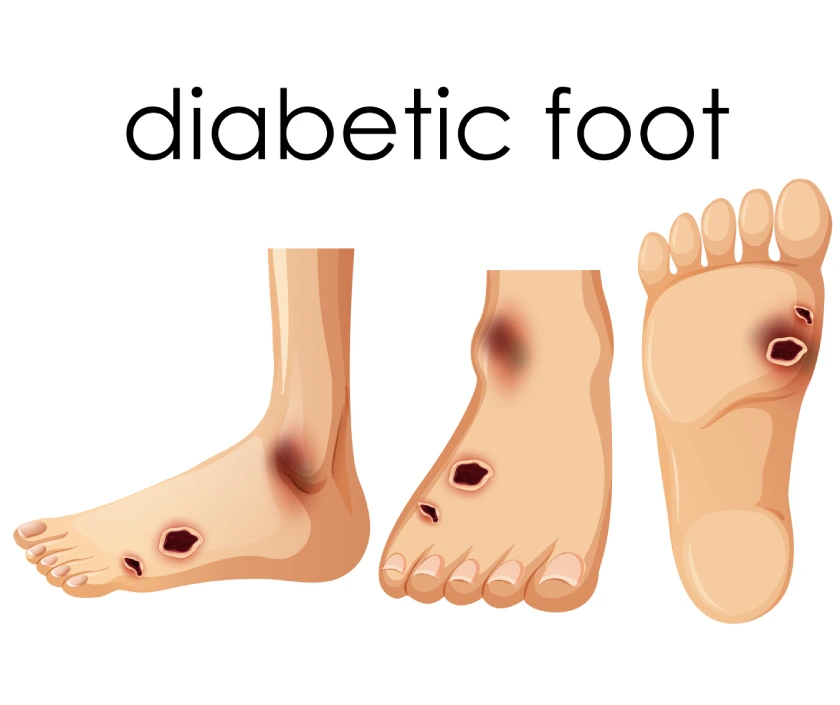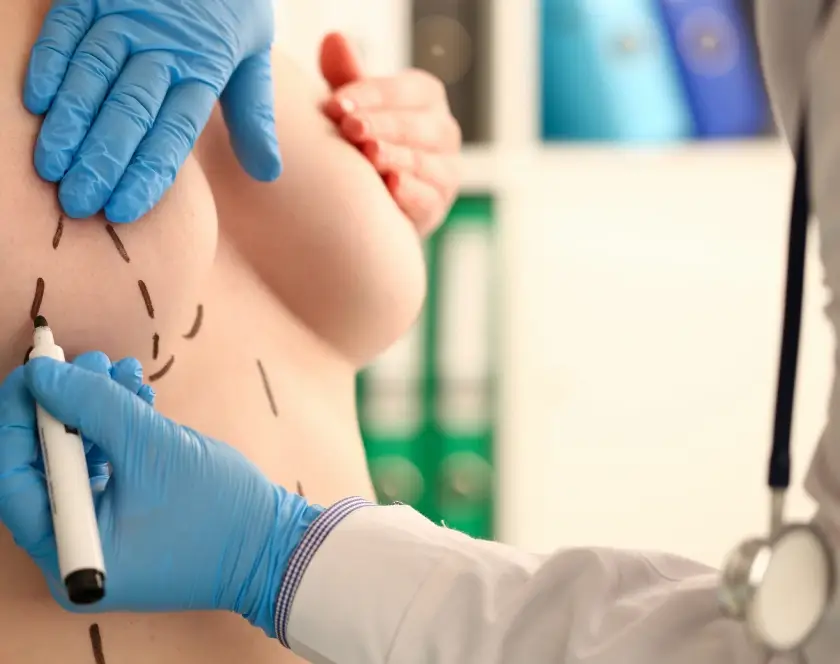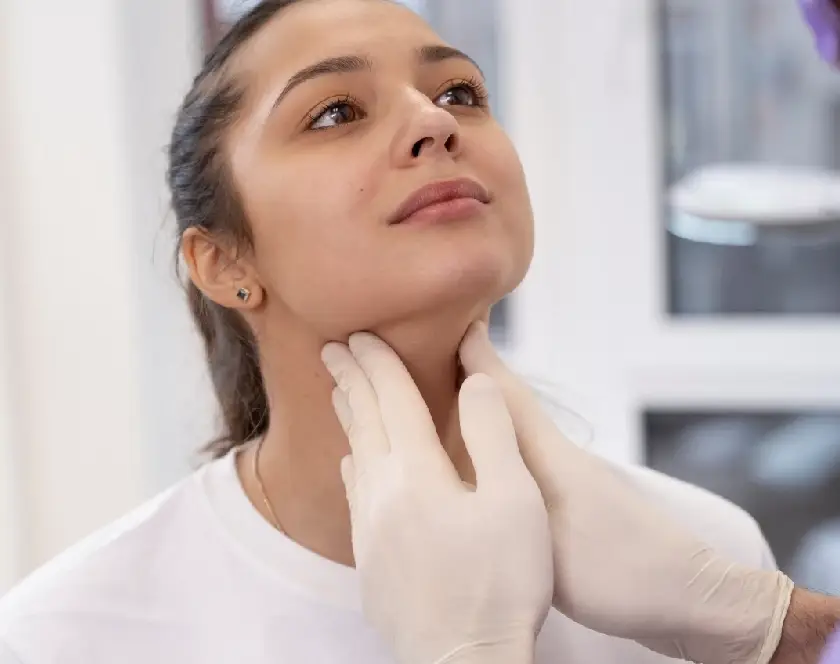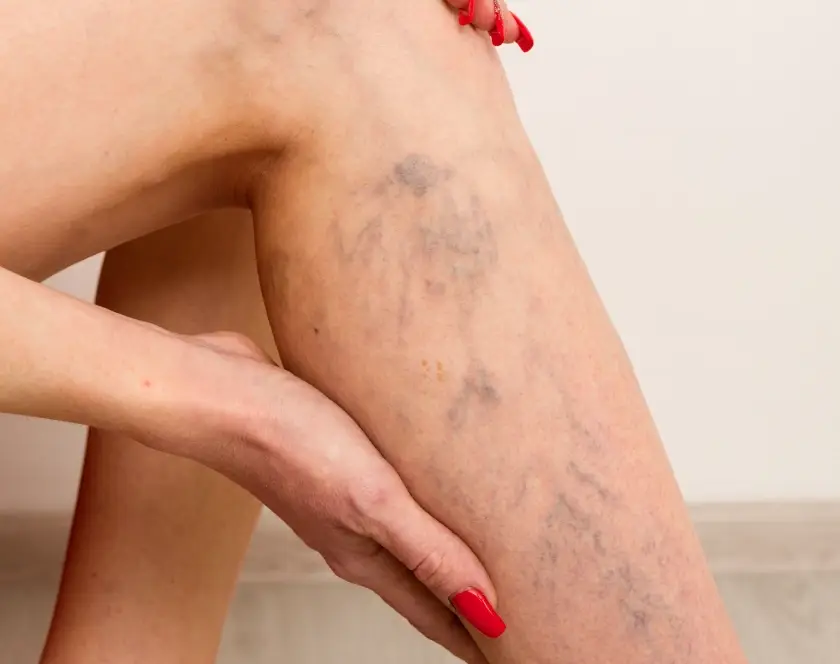Diabetic foot and wound management is a specialized service aimed at preventing, treating, and reconstructing foot conditions that arise due to diabetes or injuries. At Elegance Clinic, our team handles everything from diabetic foot ulcer management and non-healing ulcer management to biomechanics surgery and advanced wound surgery, ensuring patients avoid complications like infections, amputations, or permanent disability.
When Is This Treatment Recommended?
You may need our diabetic foot care and wound care clinic services if you experience:
- Persistent non-healing ulcer in the leg or foot
- Recurrent cellulitis or redness and swelling around wounds
- Ingrown nails leading to infection
- Deformities like flat foot or Charcot foot, causing abnormal pressure points
- Open wounds that are slow to heal despite treatment
- Signs of gangrene or severe tissue damage
It is to be noted that early intervention prevents limb-threatening complications.
Types of Conditions Treated at Elegance Clinic
We offer comprehensive management for:
- Non-healing ulcer and non-healing leg ulcer treatment
- Biomechanics surgery for foot alignment issues
- Advanced wound surgery for complex or infected wounds
- Debridement to remove dead or infected tissue
- Amputation: AK, BK, toe when necessary to save life or limb
- Flat foot correction procedures
- Charcot foot reconstruction to improve stability
- Foot deformity correction to prevent recurring ulcers
- Ingrown nail correction for chronic pain or infections
- Gangrene management with timely surgical intervention
- Cellulitis management with wound care and antibiotics
- Limb swelling management to improve circulation and healing
What Happens Before This Treatment?
Before any procedure, our specialists perform:
- A detailed examination of the foot and wound
- Imaging tests (X‑ray, Doppler, or MRI) to assess bone, soft tissue, and circulation
- Blood tests to check infection markers and healing capacity
- A review of your overall diabetic control and medical history
- You’ll receive a tailored plan including wound cleaning, diabetic foot ulcer dressing procedure, and offloading techniques to reduce pressure on the wound.
How Does This Treatment Work?
Depending on your condition:
- Debridement is performed to remove infected or dead tissue and promote healing.
- Advanced wound surgery or skin grafting may be used for large ulcers.
- Biomechanics surgery corrects structural issues causing abnormal pressure.
- In severe cases, amputation (AK, BK, or toe) may be performed to prevent infection spread.
- Cellulitis management includes drainage, antibiotics, and dressing.
- Pressure offloading devices and custom footwear are provided to prevent recurrence.
How Long Does This Treatment Take?
The duration varies with complexity:
- A simple diabetic foot ulcer dressing procedure may take 30–45 minutes.
- Advanced wound surgery or biomechanics surgery may take a few hours.
- Recovery and follow‑up dressing sessions continue for weeks to months until complete healing is achieved.
Risks and Benefits
Benefits:
- Prevents limb loss and severe infections
- Promotes faster healing of non-healing ulcers
- Improves foot structure and long‑term mobility
- Reduces pain and improves quality of life
Risks:
- Infection or delayed healing in some cases
- Scar formation or need for additional surgeries
- Rare risks related to anesthesia or circulation issues
Post‑Treatment Care
- Keep the surgical site clean and dry
- Follow all instructions for dressings and offloading devices
- Attend regular follow‑up appointments at our diabetic foot care and wound care clinic
- Maintain good blood sugar control and wear recommended footwear
- Perform physiotherapy if advised for mobility and strength
What Can I Expect for Recovery?
Recovery depends on the severity of your condition:
- Minor procedures like ingrown nail correction may heal within weeks.
- Non-healing ulcer management or debridement may take several months with ongoing care.
- More complex cases like Charcot foot reconstruction or biomechanics surgery involve longer rehabilitation and physiotherapy.
When to Consult a Doctor?
Seek immediate medical care if you notice:
- A wound or sore that isn’t healing within a few days
- Increased redness, swelling, or drainage (signs of infection)
- Blackened tissue indicating gangrene
- Severe pain, numbness, or sudden swelling in your foot or leg
- Prompt consultation can prevent complications and save your limb.
At Elegance Clinic, our goal is to provide comprehensive, advanced care for every aspect of diabetic foot health. From diabetic foot ulcer management to gangrene management and advanced wound surgery, we are here to help you walk with confidence again.
Hear from our patients
EXCELLENTTrustindex verifies that the original source of the review is Google. Dr.shah is very kind and understanding... during my surgery of xentholesma..sir didn't late me feel nervous at all..he kept talking to me..he kept singing classic old hindi songs while performing surgery..I was like "ye to apne type ka banda hai"..I didn't even realise when my surgery got over. mr. Bhargav in staff and other team members were very kind an supportive.. I just have one minor complaint..simple panipuri wala or vegetable person in surat is always ready to receive online,UPI ,QR payment..but,pharmacist over their always be like "mera to cash payment hoga". Rest all is good.. people over there are very sincere at their work. I would definitely suggest to visit elegance clinic for getting your xentholesma cured.treatment charges are also affordable.Posted onTrustindex verifies that the original source of the review is Google. I am fully satisfied my hydrafacial treatmentPosted onTrustindex verifies that the original source of the review is Google. The experience was too good staff was really humble and the results were actually good!Posted onTrustindex verifies that the original source of the review is Google. I got hair transplant which is very painful but Got it done on ELEGANCE so it was very normal and which was bery helpful for me Special thanks to staff.Posted onTrustindex verifies that the original source of the review is Google. I had PRP and laser treatments at Elegance clinic for my skin and hair, and the experience has been truly excellent. Dr. Krina handled my skin treatment with great care and attention — I noticed a visible improvement in my skin texture and glow. For my hair, Dr. Bhargav and Dr. Ashutosh guided me through the PRP sessions with patience and professionalism, ensuring I was comfortable and well-informed throughout. The entire staff is polite, supportive, and the clinic maintains high standards of hygiene and advanced equipment. Overall, I’m very satisfied with the results and would highly recommend this hospital to anyone looking for genuine care and effective treatmPosted onTrustindex verifies that the original source of the review is Google. Dr Asutosh sir is very excellent Tammy tack sargary..Posted onTrustindex verifies that the original source of the review is Google. A good doctor clinic review often highlights a clinic's positive aspects, such as a doctor's expertise, a friendly and competent staff, convenient hours, and a clean, comfortable environment.Posted onTrustindex verifies that the original source of the review is Google. After suffering a serious burn injury due to a machine accident, I was fortunate to be treated by Dr. Ashutosh Shah at Elegance Clinic. His skill and calm approach gave me confidence from the first consultation. The surgery was done with great care, and the recovery support was outstanding. The clinic is clean and peaceful, and the staff treats you like family. Forever thankful for their help during a very tough timePosted onTrustindex verifies that the original source of the review is Google. One of the best doctors as well as staff in the town, just loved the process post surgery, follow up calls is non negotiable for them. Dr ashutosh shah and dr chetan were incredible. Best service provided by the elegance clinic!Posted onTrustindex verifies that the original source of the review is Google. "We had a wonderful experience at Elegance Clinic for my wife's HIFU treatment. The staff was friendly and supportive, and the clinic environment was very professional. Dr. Ashutosh Shah took the time to explain the procedure and what to expect. The final result is excellent—my wife's skin looks much firmer and rejuvenated. She is very happy, which makes me happy! A truly world-class clinic for aesthetic procedures
Contact Us
Ready to discuss? Fill out our contact form for a confidential consultation.
FAQ
What is diabetic foot and wound management?
It is a specialized treatment plan to heal foot ulcers, infections, and structural problems caused by diabetes. It includes diabetic foot ulcer management, wound care, surgeries, and preventive measures to protect your feet.
When should I visit a diabetic foot care and wound care clinic?
Visit as soon as you notice any non-healing ulcer in the leg or foot, swelling, redness, pain, or blackish discoloration. Early care prevents major complications.
What procedures are done for diabetic foot ulcers?
Depending on the severity, treatments include debridement, diabetic foot ulcer dressing procedure, advanced wound surgery, biomechanics surgery, or even amputation – AK, BK, toe if necessary.
How is a non-healing leg ulcer treated?
Our team uses a combination of non-healing leg ulcer treatment methods: wound cleaning, offloading pressure, skin grafts, and infection control measures like cellulitis management.







